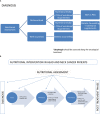The Multidisciplinary Team (MDT) Approach and Quality of Care
- PMID: 32266126
- PMCID: PMC7100151
- DOI: 10.3389/fonc.2020.00085
The Multidisciplinary Team (MDT) Approach and Quality of Care
Abstract
The core function of a multidisciplinary team (MDT) is to bring together a group of healthcare professionals from different fields in order to determine patients' treatment plan. Most of head and neck cancer (HNC) units are currently led by MDTs that at least include ENT and maxillofacial surgeons, radiation and medical oncologists. HNC often compromise relevant structures of the upper aerodigestive tract involving functions such as speech, swallowing and breathing, among others. The impairment of these functions can significantly impact patients' quality of life and psychosocial status, and highlights the crucial role of specialized nurses, dietitians, psycho-oncologists, social workers, and onco-geriatricians, among others. Hence, these professionals should be integrated in HNC MDTs. In addition, involving translational research teams should also be considered, as it will help reducing the existing gap between basic research and the daily clinical practice. The aim of this comprehensive review is to assess the role of the different supportive disciplines integrated in an MDT and how they help providing a better care to HNC patients during diagnosis, treatment and follow up.
Keywords: head and cancer unit; head and neck cancer; multidisciplinary team; quality of care; tumor board.
Copyright © 2020 Taberna, Gil Moncayo, Jané-Salas, Antonio, Arribas, Vilajosana, Peralvez Torres and Mesía.
Figures





References
Publication types
LinkOut - more resources
Full Text Sources
Medical
Research Materials
Miscellaneous

